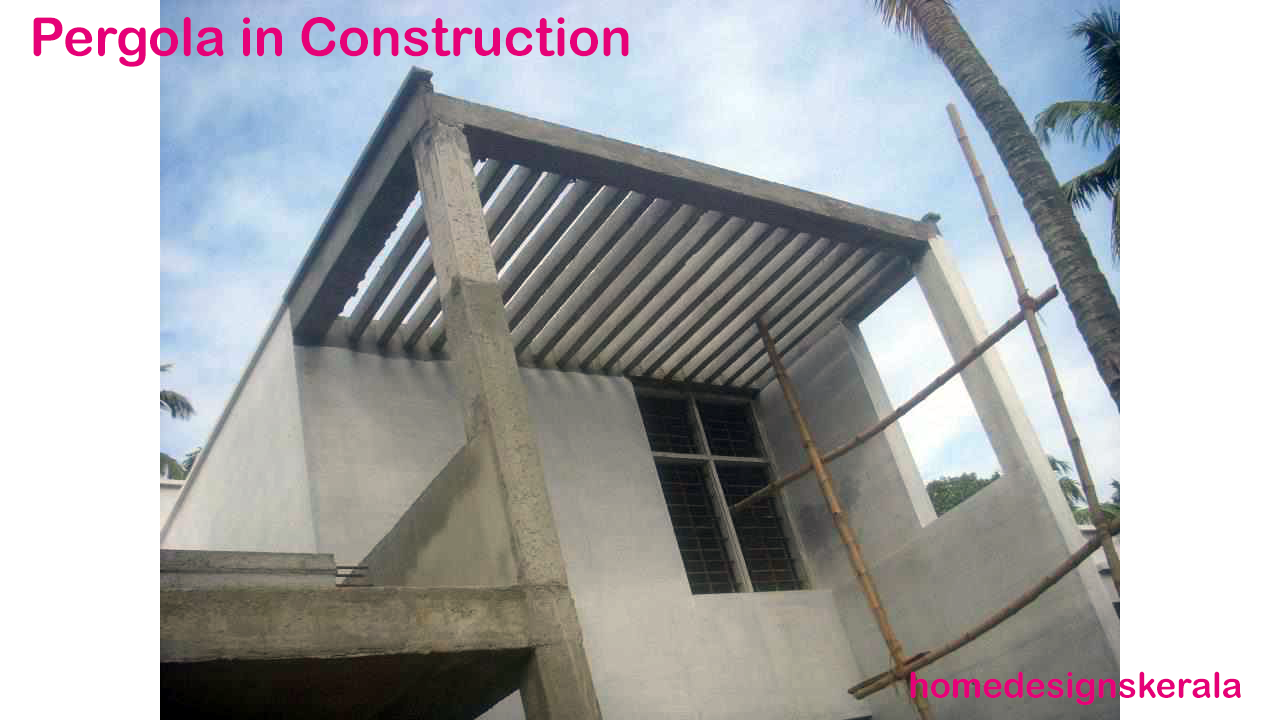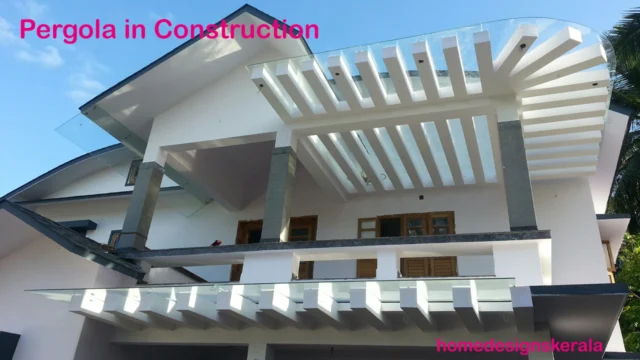A pergola is a shape commonly utilized in outdoor spaces, including gardens, patios, or yards, to provide a shaded walkway, passageway, or sitting region. It consists of vertical posts or pillars that support move-beams and an open lattice or framework above, which can be left open or included with climbing plant life, vines, or fabric for delivered coloration and aesthetics.
Here are some key functions and uses of pergolas in creation:
Shade and Shelter: Pergolas provide partial shade, making them best for outdoor seating regions, dining spaces, or walkways. The overhead shape can provide remedy from direct daylight even as nonetheless allowing some mild to filter out through.

Architectural Appeal: Apart from their useful components, pergolas add architectural interest and decorate the cultured attraction of outdoor spaces. They can serve as focal points or design factors that complement the overall panorama or architectural fashion of belongings.
Versatility: Pergolas may be designed and customized in numerous patterns, sizes, and substances to fit specific alternatives and necessities. Common materials used for pergolas include wood, vinyl, steel, and composite substances.
Integration with Plants: One of the distinctive capabilities of pergolas is their capability to aid mountain climbing flowers, vines, or flora. As plant life develops and intertwines with the shape, they could create a natural green cover, supplying additional color, privateness, and visual interest.
Functionality: In addition to supplying shade and aesthetic enchantment, pergolas can serve more than one purpose depending on the design and format. They may be used as extensions of living spaces, outdoor kitchens, recreational areas, or as a transition among exclusive regions of a landscape.
Overall, pergolas are flexible systems in construction that combine capability and aesthetics, creating inviting outdoor spaces for relaxation, entertainment, and amusement.
Materials and Durability:
Wood: Cedar, redwood, and stress-treated pine are commonplace alternatives due to their herbal beauty and durability in opposition to outdoor factors. Hardwoods like teak or ipe provide superior energy and longevity however come at a higher price.
Vinyl: Vinyl pergolas are low upkeep and proof against rot, decay, and bug harm. They offer a smooth, current look however might also lack the natural aesthetics of wood.
Metal: Aluminum or metal pergolas provide energy and sturdiness. They are frequently powder-covered to withstand rust and may offer a cutting-edge or traditional design relying on the fashion and end.
Design and Customization:
Pergolas come in various designs, along with traditional, current, rustic, or Mediterranean patterns, among others. Customization options consisting of ornamental end cuts, lattice patterns, or included lighting can beautify the arrival and capability of the shape.
The length, shape, and layout of a pergola may be tailored to healthy particular areas and necessities, whether it is a small outdoor patio or a large outdoor enjoyment place.
Roofing and Coverings:
While pergolas traditionally function as an open lattice or framework, a few designs comprise retractable canopies, material sails, or polycarbonate panels to provide additional coloration, protection from rain, or privateness.
The choice of roofing or covering material relies upon the favored stage of protection, aesthetics, and maintenance issues.
Construction and Installation:
Building a pergola requires careful planning, education, and construction strategies to ensure structural integrity and longevity.
Proper anchoring, submit placement, beam alignment, and securing techniques are crucial aspects of the setup procedure to face up to wind loads, seasonal modifications, and environmental elements.
Maintenance and Care:
Regular maintenance along with cleaning, sealing, and analyzing the shape enables extend its lifespan and appearance.
Wood pergolas might also require periodic staining, sealing, or painting to guard against moisture, UV rays, and natural wear over the years.
Metal and vinyl pergolas normally require less renovation however gain from occasional cleansing and inspection for symptoms of damage or put on.
In summary, pergolas provide a blend of purposeful and aesthetic benefits in outdoor construction, providing color, architectural interest, and versatile layout options for numerous residential and business settings. Proper design, fabric selection, creation techniques, and maintenance practices contribute to developing long-lasting, appealing, and functional pergola systems tailored to particular choices and environments.
Lighting and Accessories:
Incorporating lighting fixtures elements such as string lighting, lanterns, or integrated furniture can decorate the ambiance and value of a pergola throughout the evening hours.
Other accessories like ceiling enthusiasts, heaters, or curtains/screens can offer additional consolation, capability, and privateness depending on the meant use and climate conditions.
Foundation and Support:
Proper foundation and aid structures are vital for the stableness and longevity of a pergola. Options may also include concrete footings, post anchors, or gravel bases relying on soil situations, local constructing codes, and structural necessities.
Ensuring adequate spacing, alignment, and bracing of posts, beams, and pass-members helps distribute loads and face up to forces from wind, snow, or different environmental factors.
Permitting and Regulations:
Before building a pergola, it is essential to test nearby building codes, zoning policies, and permit necessities. Some jurisdictions may additionally have specific pointers, top regulations, setback requirements, or property line issues that dictate the design, place, and construction of outside structures.
Consulting with neighborhood authorities or an authorized expert can help navigate regulatory necessities and make certain compliance with applicable standards and suggestions.
Climate and Environmental Factors:
Considering climate situations together with temperature versions, precipitation, wind publicity, and sun orientation is vital in designing and constructing pergolas.
Selecting suitable materials, finishes, and construction strategies that resist local weather situations, seasonal adjustments, and environmental elements enables maintaining structural integrity, appearance, and overall performance over the years.
Integration with Landscape and Architecture:
Harmonizing pergola layout, materials, and aesthetics with present landscape functions, architectural factors, and standard belongings style creates a cohesive and visually attractive outside environment.
Incorporating plants, landscaping factors, water capabilities, or complementary systems (e.g., patios, decks, gazebos) complements the combination, capability, and amusement of outdoor spaces.
Cost and Budgeting:
Evaluating the cost factors associated with pergola production, together with substances, exertions, layout complexity, size, add-ons, and placement coaching, allows for setting up a practical price range and prioritizing crucial factors.
Comparing different alternatives, obtaining a couple of costs from contractors, and thinking about long-term cost, durability, and renovation expenses can guide decision-making and funding in a pergola mission.
In the end, pergolas offer versatile and customizable solutions for reinforcing outdoor spaces, supplying coloration, aesthetics, functionality, and cost to residential and business houses. Careful planning, design considerations, fabric selection, production practices, and compliance with local rules contribute to growing a hit pergola installations tailored to precise needs, choices, and environments.
Modular and DIY Options:
With the developing recognition of outside dwelling areas and domestic development projects, modular or prefabricated pergola kits have grown to be had, providing house owners with DIY-pleasant alternatives for assembly and set up.
These kits often come with pre-reduced components, assembly instructions, and hardware, simplifying the construction manner and offering cost-powerful solutions for those with fundamental carpentry competencies.

Technology Integration:
Incorporating technology functions along with an integrated audio system, Wi-Fi connectivity, or smart light controls permits stronger functionality, entertainment alternatives, and comfort within pergola structures.
Integration with domestic automation structures, far-flung manage options, or cellular packages can provide personalized settings, scheduling, and manipulation of various pergola capabilities and accessories.
Sustainability and Eco-Friendly Practices:
Utilizing sustainable substances, recycled additives, or eco-friendly construction practices can reduce environmental effects, conserve resources, and promote sustainability in pergola design and production.
Incorporating inexperienced roofing, rainwater harvesting, or native plantings within pergola systems contributes to ecological blessings, energy efficiency, and environmental stewardship.
Multi-Functional and Adaptive Spaces:
Designing pergolas with multi-purposeful elements including adjustable louvers, retractable awnings, or modular additives allows for adaptive use, flexibility, and flexibility in outside spaces.
Creating incorporated seating regions, garage solutions, or flexible layouts comprises diverse sports, activities, and seasonal modifications, maximizing usability, comfort, and enjoyment throughout the year.
Artistic and Custom Designs:
Exploring inventive elements, custom designs, or personalized features in pergola production gives precise, exclusive, and creative expressions tailored to personal choices, issues, or architectural patterns. Read also this: What is Modular Kitchen. Advantages
Collaborating with designers, artisans, or craftsmen permits the incorporation of custom info, inventive motifs, or signature factors that reflect cultural influences, ancient contexts, or inventive visions inside pergola projects.
Maintenance-Free and Long-Lasting Materials:
Advancements in materials era, coatings, and finishes have led to the improvement of preservation-unfastened, durable, and long-lasting alternatives for pergola construction.
Selecting substances with UV-resistant, climate-resistant, or low-maintenance houses, along with composite materials, fiberglass, or specialized finishes, enables decreased protection, lengthening lifespan, and enhanced appearance through the years.
In precis, pergolas continue to evolve with modern designs, materials, technology, and trends that cater to numerous preferences, lifestyles, and environmental concerns. Incorporating modular alternatives, era features, sustainability practices, multi-useful factors, creative designs, and renovation-unfastened materials gives opportunities for creativity, customization, efficiency, and durability in pergola creation and entertainment of out-of-door spaces.









